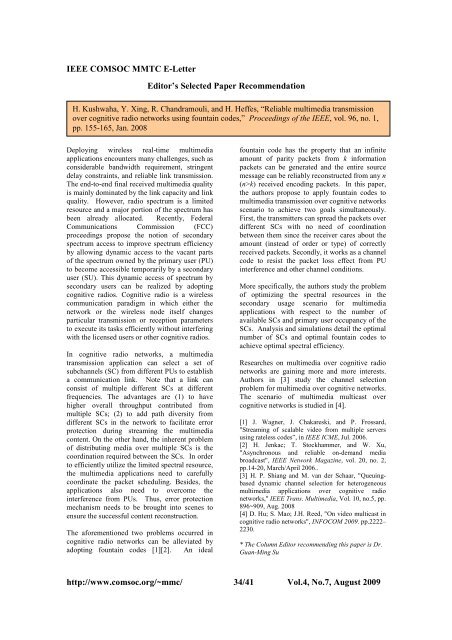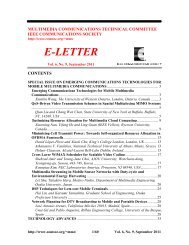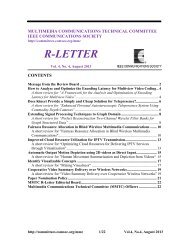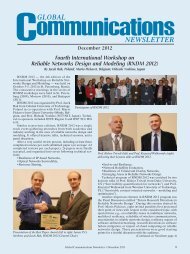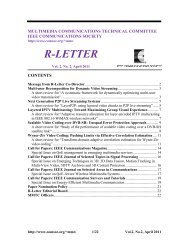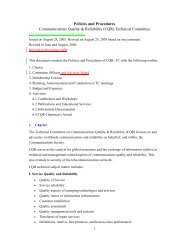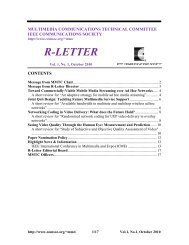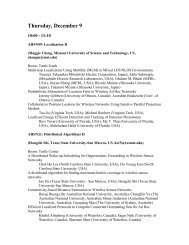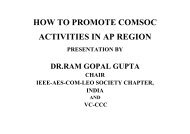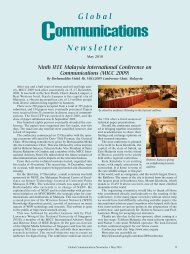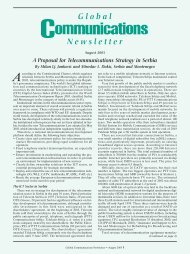E-LETTER - IEEE Communications Society
E-LETTER - IEEE Communications Society
E-LETTER - IEEE Communications Society
You also want an ePaper? Increase the reach of your titles
YUMPU automatically turns print PDFs into web optimized ePapers that Google loves.
<strong>IEEE</strong> COMSOC MMTC E-LetterEditor’s Selected Paper RecommendationH. Kushwaha, Y. Xing, R. Chandramouli, and H. Heffes, “Reliable multimedia transmissionover cognitive radio networks using fountain codes,” Proceedings of the <strong>IEEE</strong>, vol. 96, no. 1,pp. 155-165, Jan. 2008Deploying wireless real-time multimediaapplications encounters many challenges, such asconsiderable bandwidth requirement, stringentdelay constraints, and reliable link transmission.The end-to-end final received multimedia qualityis mainly dominated by the link capacity and linkquality. However, radio spectrum is a limitedresource and a major portion of the spectrum hasbeen already allocated. Recently, Federal<strong>Communications</strong> Commission (FCC)proceedings propose the notion of secondaryspectrum access to improve spectrum efficiencyby allowing dynamic access to the vacant partsof the spectrum owned by the primary user (PU)to become accessible temporarily by a secondaryuser (SU). This dynamic access of spectrum bysecondary users can be realized by adoptingcognitive radios. Cognitive radio is a wirelesscommunication paradigm in which either thenetwork or the wireless node itself changesparticular transmission or reception parametersto execute its tasks efficiently without interferingwith the licensed users or other cognitive radios.In cognitive radio networks, a multimediatransmission application can select a set ofsubchannels (SC) from different PUs to establisha communication link. Note that a link canconsist of multiple different SCs at differentfrequencies. The advantages are (1) to havehigher overall throughput contributed frommultiple SCs; (2) to add path diversity fromdifferent SCs in the network to facilitate errorprotection during streaming the multimediacontent. On the other hand, the inherent problemof distributing media over multiple SCs is thecoordination required between the SCs. In orderto efficiently utilize the limited spectral resource,the multimedia applications need to carefullycoordinate the packet scheduling. Besides, theapplications also need to overcome theinterference from PUs. Thus, error protectionmechanism needs to be brought into scenes toensure the successful content reconstruction.The aforementioned two problems occurred incognitive radio networks can be alleviated byadopting fountain codes [1][2]. An idealfountain code has the property that an infiniteamount of parity packets from k informationpackets can be generated and the entire sourcemessage can be reliably reconstructed from any n(n>k) received encoding packets. In this paper,the authors propose to apply fountain codes tomultimedia transmission over cognitive networksscenario to achieve two goals simultaneously.First, the transmitters can spread the packets overdifferent SCs with no need of coordinationbetween them since the receiver cares about theamount (instead of order or type) of correctlyreceived packets. Secondly, it works as a channelcode to resist the packet loss effect from PUinterference and other channel conditions.More specifically, the authors study the problemof optimizing the spectral resources in thesecondary usage scenario for multimediaapplications with respect to the number ofavailable SCs and primary user occupancy of theSCs. Analysis and simulations detail the optimalnumber of SCs and optimal fountain codes toachieve optimal spectral efficiency.Researches on multimedia over cognitive radionetworks are gaining more and more interests.Authors in [3] study the channel selectionproblem for multimedia over cognitive networks.The scenario of multimedia multicast overcognitive networks is studied in [4].[1] J. Wagner, J. Chakareski, and P. Frossard,"Streaming of scalable video from multiple serversusing rateless codes”, in <strong>IEEE</strong> ICME, Jul. 2006.[2] H. Jenkac; T. Stockhammer, and W. Xu,"Asynchronous and reliable on-demand mediabroadcast", <strong>IEEE</strong> Network Magazine, vol. 20, no. 2,pp.14-20, March/April 2006..[3] H. P. Shiang and M. van der Schaar, "Queuingbaseddynamic channel selection for heterogeneousmultimedia applications over cognitive radionetworks," <strong>IEEE</strong> Trans. Multimedia, Vol. 10, no.5, pp.896~909, Aug. 2008[4] D. Hu; S. Mao; J.H. Reed, "On video multicast incognitive radio networks", INFOCOM 2009. pp.2222–2230.* The Column Editor recommending this paper is Dr.Guan-Ming Suhttp://www.comsoc.org/~mmc/ 34/41 Vol.4, No.7, August 2009


